Among the variety of clothing styles, it is difficult to find a more free, daring and, at the same time, democratic trend than boho. For women who know how to sew and knit, inexhaustible opportunities open up for the embodiment of the most unexpected creative fantasies.
Characteristic features of the Boho style in knitted items
The term "boho" comes from the nomadic gypsies who lived in Bohemia. Later it went beyond one ethnic group and began to be applied to people leading a free, "bohemian" lifestyle. The images reflect external relaxedness and a creative view of the surrounding world.
Boho style clothing has the following features:
- eclecticism;
- multi-layered;
- environmental friendliness;
- a tendency towards loose silhouettes.
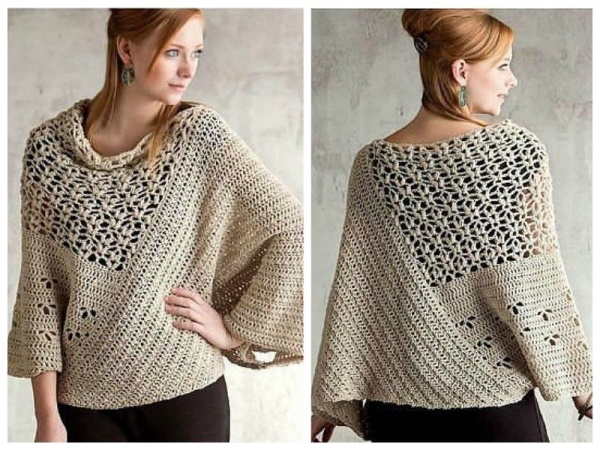
Boho is characterized by elements of different ethnic or social cultures: gypsy, oriental, hippie.
The image may contain “echoes” of stylistic trends:
- Ethno;
- Vintage;
- Safari and others.
Fans of the trend willingly wear clothes knitted or crocheted, woven accessories, and beaded jewelry. Handmade items are one of the main features of the style.

Boho knitting for women involves free mixing of different techniques and elements:
- openwork;
- jacquard;
- large patch elements (pockets, patches);
- knitted flowers;
- frills and flounces;
- arans and braids;
- embroidery on knitted fabric;
- fringe.
Materials must be natural or contain at least 50% natural raw materials: wool, cotton, linen. Synthetics contradict the style and concept of boho.
The color scheme can be either bright or subdued. Contrasting color stripes, geometry, and ethnic patterns are appropriate. Restrained natural colors reminiscent of rough homespun clothing do not contradict the style.
Boho lovers willingly wear loose sweaters and tunics, ponchos, skirts and dresses with frills. Often knitting and crocheting are combined in one item.
Selecting yarns and knitting needles for knitting women's clothes
You need to select materials and tools taking into account the season, the style of the future item and personal preferences.When buying threads, you need to consider their thickness and composition. This information is indicated on the yarn label. You should also calculate the amount of material in advance and take it with a small reserve.
For summer models, thin linen or cotton yarn is suitable, for winter models - wool or semi-wool. Beginners should keep in mind that working with very thin yarn requires some experience. Knitting takes much more time than when working with medium-thick threads.

A thing made of pure wool yarn can shrink a lot after washing. Also, pure wool is not suitable for people with sensitive skin. Therefore, it is better to take a mixed thread with a wool content of 50-90% for work.
There should be several pairs of straight and circular knitting needles of different sizes. You can choose metal, wooden or plastic knitting needles. You should not buy aluminum knitting needles, as they are easily deformed under the weight of the knitted fabric. The thinnest ones can break during work. Aluminum often leaves dark marks on light yarn.
The spokes must be smooth, without nicks or surface defects. When buying circular knitting needles, you need to pay attention to the strength of the cable fastening. A tool with a defect can damage the knitted fabric and ruin the work.
Boho knitting for women allows for a combination of different techniques. Therefore, it is necessary to purchase several crochet hooks of different sizes. You will also need needles for sewing knitwear, scissors and a tape measure. Depending on the design concept, you may need decorative buttons, beads, embroidery threads, lace and the like.
Abbreviations used in master classes
In the working descriptions of the models, special abbreviations will be used:
- p. – loop (loops);
- p. – row(s);
- l. p. – front loop;
- persons - facial;
- purl stitch – purl loop;
- purl – wrong side;
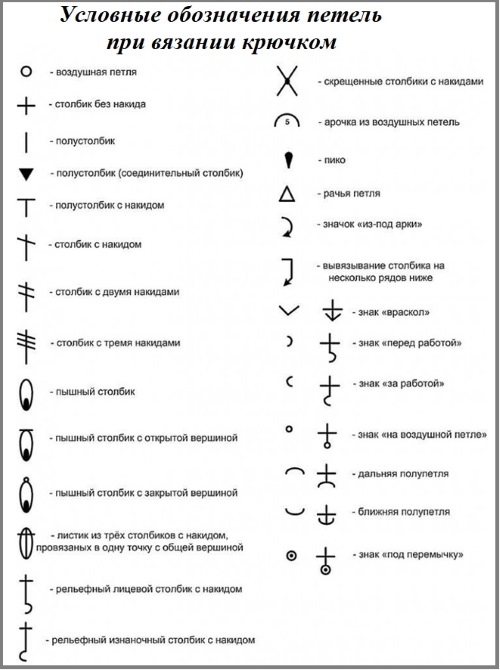
- kr. p. – edge loop(s);
- l. r. – front row;
- from. p. – purl row;
- crossed loop – crossed loop;
- knit crossed stitch – knit crossed stitch.
Step by step instructions for knitting women's clothing in the Boho style with knitting needles
To knit these patterns, you only need basic knitting skills and precise adherence to the work descriptions.
Tunic
For this model you will need white or light beige linen yarn with a thickness of 190 m per 100 g:
| Size | Amount of yarn | Length | Back/front width | ||
| Tunic in its entirety | From the bottom edge to the armhole | Shoulder | |||
| 40/42 | 700 g | 67 cm | 44 cm | 20.5 cm | 61 cm |
| 44/46 | 750 g | 69 cm | 46 cm | 22.5 cm | 65 cm |
| 48/50 | 800 g | 71 cm | 48 cm | 24.5 cm | 69 cm |
You will need 2 pairs of knitting needles No. 3 and 3.5, a needle for sewing knitwear.
It is enough to create a pattern for one piece, since they differ only in the shape of the neckline:
- Draw a rectangle whose sides correspond to the length and width of the part.
- Mark the armholes with dots.
- Measure 14 cm from the armholes on both sides.
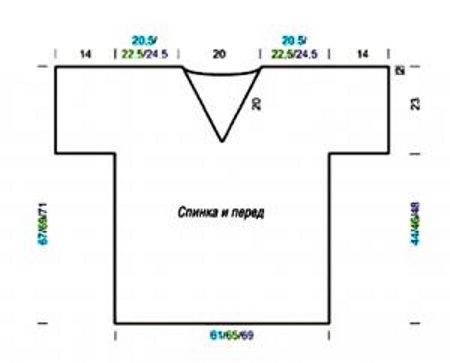
- Draw the sleeve, extending the shoulder line.
- Mark 20 cm in the middle of the top edge and draw the neckline as shown on the pattern.
During the work, periodically apply the fabric to the drawing, checking the dimensions. The tunic is combined from several patterns. Odd rows in each of them, starting with 1, should be knitted on the front side, even ones - on the back side.
| Pattern name | Number of loops | Operating procedure |
| "Holes 1" | Even + 1 st + 2 cr. st. | 1-3 rows knit sl sts between sl sts. 4th row: 1 kr. p., 1 l. p., repeat *1 yarn over, slip 1 st., knit the next st. and pull through the slipped st.*, 1 l. p., 1 kr. p. |
| "Holes 2" | Multiple of 4 + 6 sts + 2 kr. sts. | 1st row between the cr. sts knit.
2nd row between purl sts. 3rd row: kr. p., 3 k. p., repeat *yarn over, 2 k. together, 2 k. p.*, yarn over, 2 k. together, 1 k. p., kr. p. Row 4: knit as Row 2. Row 5: knit as Row 1. 6th row: purl, 3 out. p., repeat *2 out. together, yarn over, 2 out. p.*, 2 out. together, yarn over, 1 out. p., purl. |
| "Shells" | Multiple of 6 + 3 sts + 2 kr. sts. | 1-3 rows knit sl st between kr sts.
4th row: kr. p., 2 out. p., repeat *yarn over, 2 out. p. together*, 1 out. p., kr. p. 5-6 rows knit sl st between kr sts. 7th row: between the cr. p. alternate 1 l. p. and 2 yarn overs. 8th row: between the cr. p., drop both yarn overs, pull out the loops and knit them as purl. 9th row: kr. p., 1 k p., 2 k. slip as if knitwise, knit 1 and pull through 2 slipped sts, then repeat: *from one st. knit 1 k p. + yarn over + 1 k p. + yarn over + 1 k p. + 3 sts. slip as if knitwise, knit the next 2 sts together and pull through 3 slipped sts.*, 1 k p. + yarn over + 1 k p. + yarn over + 1 k p., 2 k. slip as if knitwise, knit 1 and pull through 2 slipped sts, 1 k p., kr. p. Repeat 2-9 times. |
| Openwork | Multiple of 6 + 1 st + 2 kr. st. | 1st row: kr. p., 1 k. p., repeat *yarn over, slip 1 st, knit the next st and pull through the slipped st., 1 k. p., 2 sts together k., yarn over, 1 k. p.*, kr. p.
2nd and all even rows up to and including 12th row knit from p. 3rd row: kr. p., 2 l. p., yarn over, repeat *3 l. p., yarn over*, 2 l. p., kr. p. 5th row: knit stitch, 2 knit stitches, yarn over, slip 1 stitch, knit the next stitch and pull it through the slipped stitch, knit stitch 1, 2 knit stitches together, yarn over, repeat *slip 1 stitch, knit the next 2 knit stitches together and pull it through the slipped stitch, yarn over, slip 1 stitch, knit the next stitch and pull it through the slipped stitch, knit stitch 1, 2 knit stitches together, yarn over*, slip 1 stitch, knit the next stitch and pull it through the slipped stitch, knit stitch 7th row: kr. p., 1 k. p., repeat *2 sts together k., yarn over, 1 k. p., yarn over, slip 1 st., knit the next st. and pull it through the slipped st., 1 k. p.*, kr. p. Row 9: knit as Row 3. 11th row: kr. p., 1 k. p., repeat *2 sts together k., yarn over, 1 k. p., yarn over, slip 1 st., knit next 2 sts together and pull through slipped st., yarn over, slip 1 st., knit next st. and pull through slipped st., 1 k. p.*, kr. p. |
| "Bumps" | Multiple of 3 + 2 rd. p. | 1st row: kr. p., 2 yarn overs, 1 l. p., repeat *1 l. p., 3 yarn overs*, 2 yarn overs, 1 l. p., kr. p.
2nd row: kr. p., 1 l. p., 2 yarn overs from previous row, drop, repeat *3 yarn overs from previous row, drop and draw up loops with right needle, then transfer these 3 sts to left needle, knit from them 1 sk. p. + 1 l. p. + 1 sk. p.*, 1 l. p., 2 yarn overs from previous row, kr. p. |
| Garter stitch | Any | All rows knit l.p. |
Boho knitting for women involves a creative approach to the process. Therefore, it is not necessary to use all the patterns in one product. According to the proposed pattern, you can create your own version of clothing, taking the image of the finished model as a basis.
Step-by-step description of knitting a tunic with all the textures considered:
- For the back panel, cast on 111 (119, 125) sts on size 3 needles.
- Knit 9 cm with the “Holes 1” pattern, counting the 1st row as purl.
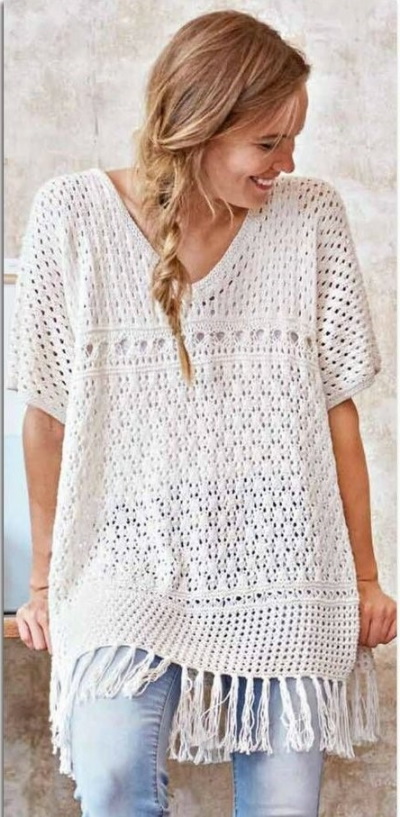
- Work 4 rows of garter stitch, evenly increasing in 1 of them 11 sts for size 40/42 and 12 sts for the rest.
- Knit 2 rows of “Bumps” on needles No. 3.5.
- Knit 4 rows in garter stitch, arbitrarily adding 1 st in 1 of them for size 40/42 or decreasing 2 sts for the rest.
- Perform 12-14 vertical openwork rapports. The height is determined arbitrarily and depends on the desired length of the item.
- Knit 2 rows in garter stitch, adding 2 sts in the first row.
- Using knitting needles No. 3, complete 1 vertical rapport (9 rows) of “Shells”.
- Using knitting needles No. 3.5, knit 2 rows in garter stitch.
- Work the next row between the long loops, alternating 1 knit stitch and 2 yarn overs.
- Knit 1 row.
- Knit 2 rows in garter stitch, adding 1 st in the first row.
- At the armhole level, add 27 (28, 27) sts for the sleeves on both sides of the fabric.
- Knit with the pattern "Holes 2" 21 cm.
- To knit the back side of the neck, close 17 sts in the middle of the fabric.
- Design each side of the neckline separately. To do this, close 7 sts twice through the row.
- Close the remaining loops.
The front part of the tunic is knitted in the same way, but with a deeper neckline:
- At a height of 47 (48, 50) cm from the beginning of the fabric, close 2 sts in the middle and knit alternately on each side.
- Close 18 times, 1 st every other row.
- In each 4th row decrease 1 st 4 more times.
- When the desired depth of the cut is achieved, close the remaining stitches.
When both panels are ready, you can assemble the product and design the neckline and sleeves. Tie the neck with 4 rows of garter stitch in a circle. In the middle of the front, you need to knit 3 knit stitches together with a drawstring. Tie the sleeves in the same way, but without decreasing. At the end of the work, attach the fringe with a crochet hook, forming bunches of 4 threads folded in half.
Skirt
A knitted skirt with a jacquard insert can become the basis for a cowboy look. The model combines “rustic” simplicity, ethnic elements and a feminine silhouette, typical of the boho style.
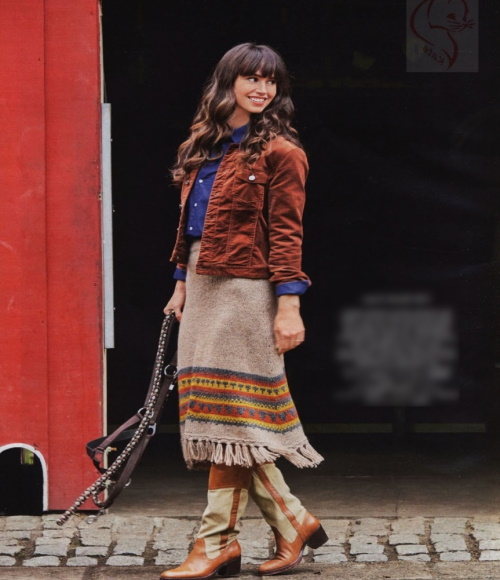
For sizes 36/38 (40/42) you will need 450 (550) g of wool or semi-wool yarn in 4 colors, 100 g thick per 200 m. The color scheme can be selected as desired: 300 (400) g of threads of the main color and 50 g of threads of 3 different colors.
You will also need 2 pairs of circular knitting needles: No. 5, 60 cm long, and No. 5.5, 80 cm long. An elastic band 2.5 cm wide will do for the belt, the length of which depends on the waist size. The skirt is knitted from the waist down with the front surface (l. r. = l. p., w. r. = w. p.), in circular rows.
The jacquard stripe should be knitted according to the pattern, completely repeating rows 1-8 and 13-38 from one double arrow to another. In rows 9-12, you only need to repeat the first 4 sts before arrow a. To construct the pattern, it is enough to take 2 measurements: waist size and skirt length.
The diagram shows ¼ of the product volume. The density of the fabric is calculated individually, based on the thickness of the thread.
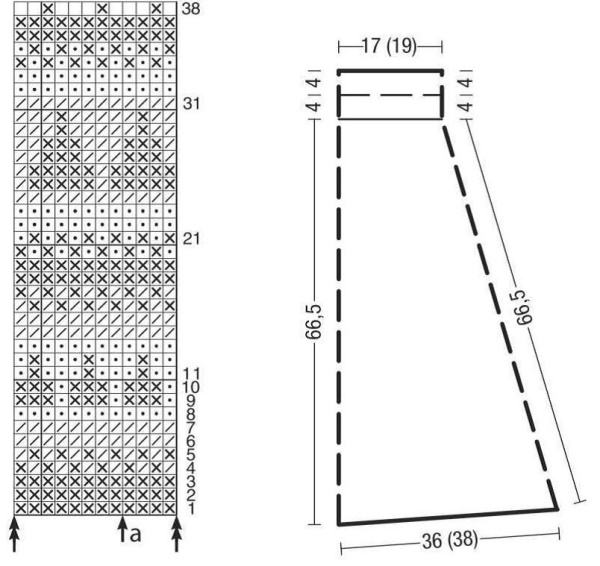
Knitting sequence of the skirt:
- Cast on 108 (120) sts on size 5 needles and knit in closed rows in a circle.
- For the belt, knit 4 cm in stockinette stitch, 1 row of stitches for the fold line and again 4 cm in stockinette stitch.
- Changing to knitting needles No. 5.5, in the 1st row after the waistband add 1 yarn over to the right and left of 28 (31) sts and from 82 (91) sts for expansion. In the next row, knit all yarn overs with crossed sts.
- Perform the same increases 17 more times every 2 rows, i.e. in the 3rd. If the needles are not long enough, you can replace them with longer ones.
- In the same way, add loops in every 5th row 3 more times and in every 6th row 2 times.
- Approximately 42 cm from the waist, start knitting the jacquard strip, and in the 2nd row make another increase (= 4 sts).
- Continue adding stitches while knitting the pattern: 3 times in row 6, 1 time in row 8, 2 times in row 5 and 1 time in row 6.
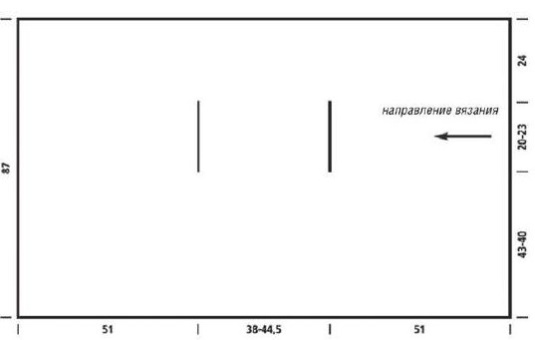
- After the jacquard stripe, knit 4.5 cm with the main color thread.
- Add 3 final rows, purl - knit - purl, and bind off.
- Fold the top part of the belt along the fold line to the wrong side and hem it, leaving a small opening for the elastic.
- Insert the elastic and carefully sew up the hole.
- For the fringe tufts, cut 5 strands 18 cm long. Attach the fringe to the hem of the skirt at intervals of 2-3 cm.
Vest
The free model of the vest-cape is universal in size. The description presents 2 options: for sizes 32-40 and 42-48. You will need pure wool yarn of different colors, 240 m thick per 100 g. You can choose the colors at your discretion, so in the description they are indicated conditionally: A - 250 g, B - 200 g, B, G and D - 150 g each.
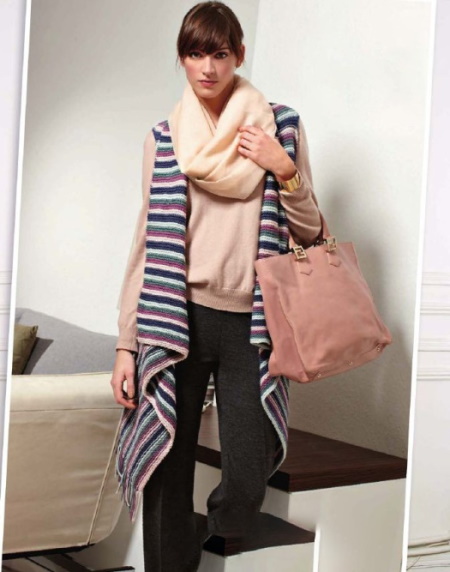
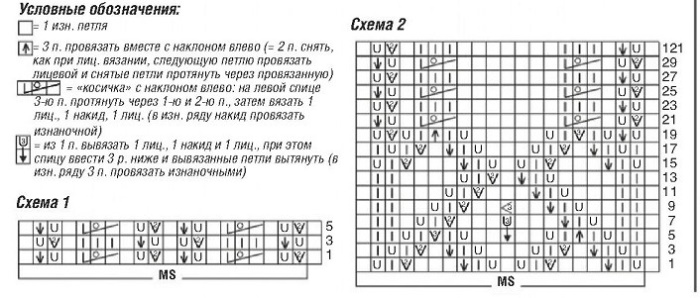
You can also choose knitting needles No. 5.5 or No. 6 depending on the desired density of the fabric. The vest should be knitted straight across. The garter stitch stripes (l. p. in all rows) alternate in the following order: 4 rows of D, B and B, 6 rows of A, 4 rows of G.
Work order:
- Cast on 158 sts with yarn G and knit 3 rows. Then continue sequentially, alternating sections of different colors. At the beginning and end of each strip, leave 10 cm long thread ends for fringe.
- After 51 cm, make a slit for the arm. To do this, after knitting 44 sts, close the next 36 (41) sts and finish knitting the remaining 78 (73) sts.
- In the next row, cast on stitches again.
- In the same way, knit the second hole 38 (44.5) cm from the first.
- Finish knitting after 140 (146.5) cm from the start.
- Tie both ends of each color of thread together.
Cardigan
Knitting in the Boho style (for women) of openwork patterns is intended for experienced craftswomen. The effectiveness of this model is provided by combining 2 types of openwork.
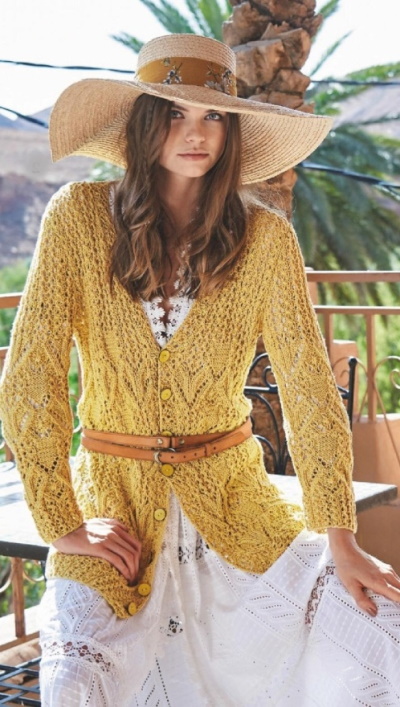
Calculations are given for sizes 36-38 and 44-46. When starting work, you need to take into account that the finished item will stretch a little in length during wear. The measurements in the diagram and in the description correspond to the product laid out on a horizontal surface.
To construct the pattern you will need the following measurements:
- chest volume;
- hip volume;
- back length:
- shoulder length;
- armhole width;
- sleeve length;
- wrist circumference;
- neck width.
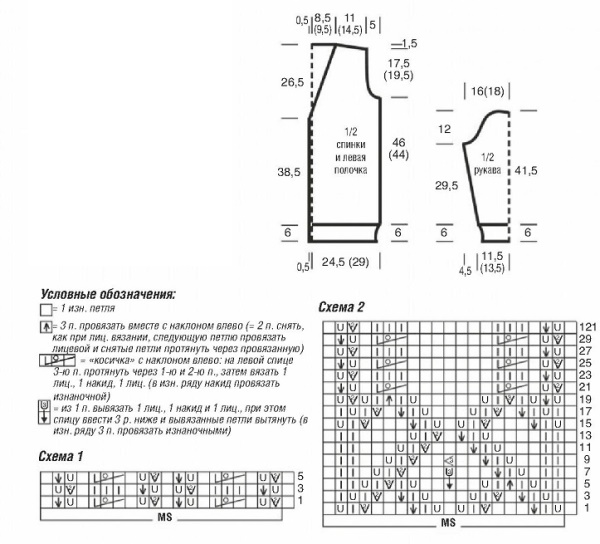
You can adjust the pattern to suit your figure or use a ready-made one. To knit a cardigan, you will need 500 (600) g of cotton yarn with a thickness of 240 m per 100 g, 2 pairs of knitting needles No. 4 - straight and circular, as well as 8 buttons in the same color as the yarn.
Both patterns are made according to the diagrams attached to the description. The density of the sample is 10 by 10 cm - 21 sts in width and 29 rows in length. It is recommended to knit your sample to make adjustments to the calculations.
Pattern 1 corresponds to diagram 1. The width of the rapport without edge stitches is 20 sts + 1 st before it. Only the LRs are shown in length. The RPs are performed according to the pattern, and the yarn overs must be knitted out of the back. The loops are distributed in the following order: RP, 1 RP, repeat the rapport the required number of times, RP. In height, 1-6 rows are knitted once, then 3-6 rows are repeated.
Pattern 2 should be knitted according to pattern 2 similarly. In height, you need to repeat 1-30 rows 4 times and knit 121-122 rows 1 time.
Step-by-step work process:
| Detail | Type of spokes | Number of stitches when casting on | Process |
| Back | Straight | 103 (123) | 1. Knit from p. 1 row. It is not taken into account in the calculations. 2. Alternate patterns: 1st – 18 rows of strip, 2nd – 122 rows, return to 1st. 3. For armholes, close from the sides: 5 sts, 3 times 1 st through a row, 2 times in each 4 rows. 4. For the shoulders, close 8 (10) sts. After 1 row, close the same number again. 5. When the total length of the piece is 71 cm, finish the work. |
| Left shelf | Straight | 52 (62) | 1. Knit from p. 1 row. It is not taken into account in the calculations.
2. Knit the lower strip in the following order: kr. p., 1 out. p., rapport 2 times, 9 (19) initial sts of the rapport, kr. p. 3. Knit 122 rows with pattern 2. 4. Continue working with pattern 1 in the same sequence as on the strip. 5. According to the pattern, decrease 1 st on the left by knitting 2 sts together before the back st. 6. Form a beveled neckline by continuing to decrease 1 st 18 times in every 4th row (8 times in every 2nd and 4th row in turn, then 12 times in every 4th). The number of yarn overs and decreases should match. 7. On the right, knit the sleeve neckline and shoulder line as on the back. 8. Knit the piece to the height of the back part and finish. |
| Right shelf | Straight | 52 (62) | Knit symmetrically. Start with the last 10 sts and repeat the pattern 2 times (do 3 patterns). Knit the neckline decreases with a leftward tilt: remove 1 st, knit the next st and pull the 1st st through it. |
| Sleeves | Straight | By 49 (57) | 1. Alternate patterns in the same order as on the other pieces. Knit pattern 2 for a total of 74 rows.
2. Pattern 1 is performed between the r. p. in the following sequence: last 4 (8) p., 2 rapports, 3 (7) initial p. In the final row, add 1 p. on each side. Along the edges, instead of decreasing, knit or r. p. 3. Pattern 2 after the red st. start with the last 5 (9) sts, knit 2 rapports, then 4 (8) initial sts and the red st. 4. For the side extensions, add 1 st along the edges 8 times in each 8 rows, including new loops in the corresponding pattern. 5. Having knitted 35.5 cm, form an armhole by closing 4 sts along the edges, then every other row 2 times by 2 sts, 12 (10) times by 1 st and 2 (4) times by 3 sts. After 47.5 cm from the beginning of the piece, finish the sleeve. |
| Side panels and collar | Circular | ≈ 343 (349) | 1. Connect the pieces with shoulder seams.
2. Cast on stitches along the edges of the strips and neckline. Knit 1 out. row out. Work 8 rows with pattern 1, starting with 1 (4) st from the end of the rapport. 3. On the right strip, knit 8 buttonholes in 6 rows, closing 2 sts and picking them up again in the next row. The lower slit should be located 9 (13) sts from the bottom of the cardigan, taking into account the right st. The remaining slits should be made at a distance of 12 sts from each other. 4. Knit the strip to a width of 3 cm and close with a l.p. |
To finish the job, you should complete all the necessary seams and sew on the buttons.
Dress
Boho knitting for women can harmoniously combine different types of patterns. The model described below successfully combines openwork, mesh and smooth fabric. Calculations are given for sizes 36-38 and 40-42.
For work you will need 600 (650) g of cotton or viscose threads with a thickness of 250 m per 100 g, straight knitting needles No. 4 for the main work and circular knitting needles No. 3 for tying the neck. The patterns are made in accordance with the diagrams.
The “mesh” should be knitted according to pattern 1, starting with the loops preceding the rapport, then repeating the rapport the required number of times and ending with the loops after it.
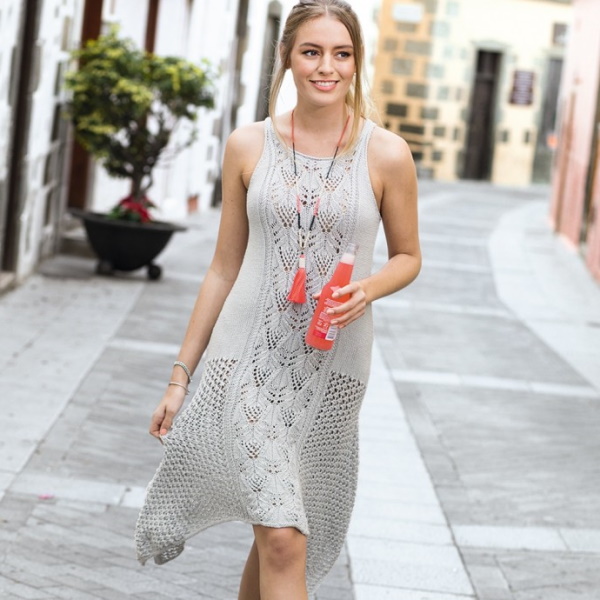
"Lace leaves" are knitted according to scheme 2. In the 1st half of the scheme, from. rows you need to knit according to the pattern, and make yarns purl. In the process of work, the rapport between the initial and final loops should be done twice.
The pattern for the strip consists of 3 rows: s. r. – l. p., l. r. – s. p., s. r. – s. p. Garter stitch is knitted l. p. in all rows. The front surface is knitted l. p. in l. r., s. p. in s. r. The back surface is s. p. in l. r., s. p. in s. r.
To make the underlined decreases after the cr. p. you need to knit 2 sts together with a leftward tilt (slip 1 st as if knit, knit the next st and pull it through the 1st st). Before the cr. p. you need to knit 2 sts together as knits.
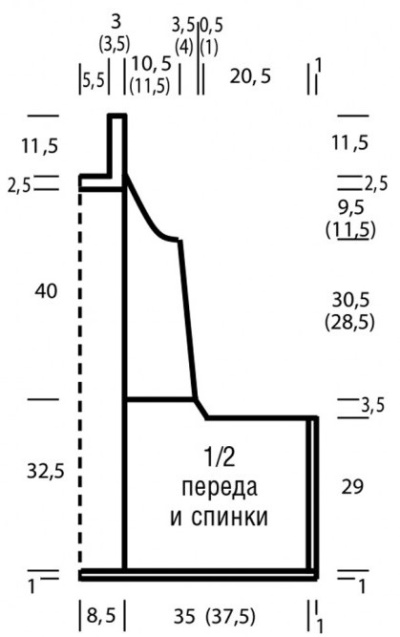
Description of the work process:
- For the back half, cast on 220 (232) sts and start with the bar.
- Continue in the following sequence: 3 sts of garter stitch, 1 st of satin stitch, 81 (87) sts of “net”, 50 sts of “openwork leaves”, 81 (87) sts of “net”, 1 st of satin stitch, 3 sts of garter stitch.
- After 30 cm, close 51 sts on each side.
- Knit 3.5 cm in the following order: kr. p., 33 (39) sts. “mesh”, 50 sts. “openwork leaves”, 33 (39) sts. “mesh”, kr. p.
- Then continue knitting the "openwork leaves" in the center, and replace the "mesh" with the front surface. The bevel on the pattern means a change in the width of the fabric due to the difference in knitting density.
- Knit 2.5 cm and make 1 underlined decrease on each side. Then decrease 7 (9) more times by 1 st in each 10 (8) rows.
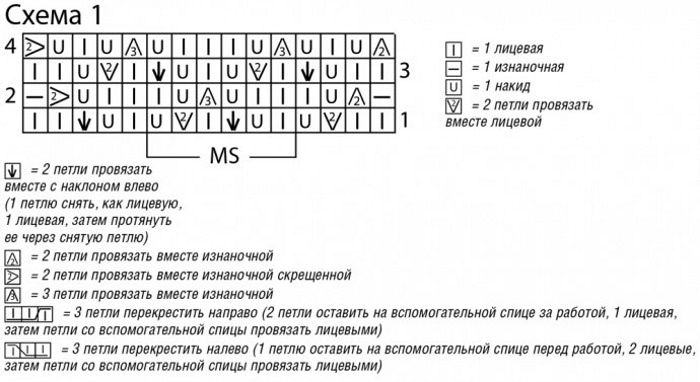
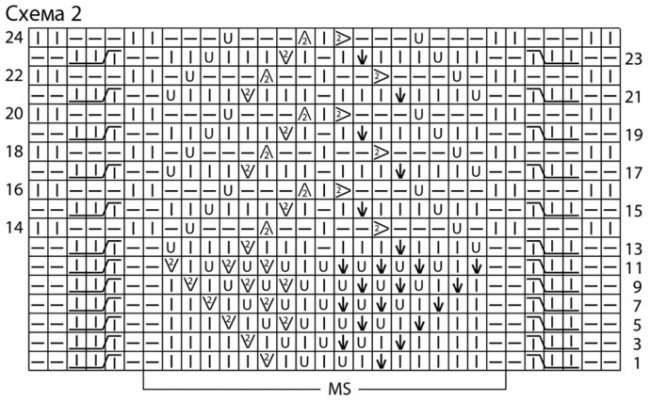
- For armholes, close 4 sts, sequentially through the row – 3 sts, 2 sts, emphasized decrease 16 (19) sts.
- For the neckline, close the middle 34 sts and knit straps of the required length.
- Knit the front part of the model in the same way, but close 34 sts in the middle 2.5 cm lower.
- Sew the halves of the dress.
- Cast on 116 sts along the neckline using circular needles and knit 2 rows. Shape the armholes in the same way, casting on 98 (106) sts. Close the stitches using the knit method.
The popularity of the boho style is due to its versatility. Any woman, regardless of age and body type, can choose a knitted clothing model for herself.
Author: Veronica Reutova
Video about knitting
Boho Knitting for Women:
